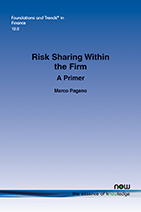Risk Sharing Within the Firm: A Primer
By Marco Pagano, University of Naples Federico II, CEPR, CSEF, ECGI and EIEF, Italy, pagano56@gmail.com
Abstract
Labor income risk is key to the welfare of most people. This risk is mainly insured “within the firm” and by public institutions, rather than by financial markets. This monograph starts by asking why such insurance is provided within the firm, and what determines its boundaries. It identifies four main constraining factors: availability of a public safety net, moral hazard on the employees’ side, moral hazard on the firms’ side, and workers’ wage bargaining power. These factors explain three empirical regularities: (i) family firms provide more employment insurance than nonfamily firms; (ii) the former pay lower real wages; and (iii) firms provide less employment insurance where public unemployment benefits are more generous. The monograph also explores the connection between risk sharing and firms’ capital structure: greater leverage calls for high wages to compensate employees for greater job risk; nevertheless, firms may want to lever up strategically in order to offset the bargaining power of labor unions. Hence, the distributional conflict between shareholders and workers may limit risk sharing within the firm. By contrast, bondholders and workers are not necessarily in conflict, as both are harmed by firms’ risk-taking. In principle, firms may also insure employees against uncertainty about their own talent, but their capacity to do so is constrained by workers’ inability to commit to their employer: in the presence of labor market competition, high-talent employees will leave unless paid in line with their high productivity, making uncertainty about talent uninsurable. The monograph concludes by showing that risk sharing within firms has declined steadily in the last three decades, and by discussing the financial, competitive, technological and institutional developments that may have conjured this outcome.
Risk Sharing Within the Firm: A Primer
Labor income risk is key to the welfare of most people and this risk is mainly insured “within the firm” and by public institutions, rather than by financial markets. Risk Sharing within the Firm: A Primer starts by asking why such insurance is provided within the firm, and what determines its boundaries. It identifies four main constraining factors: availability of a public safety net, moral hazard on the employees’ side, moral hazard on the firms’ side, and workers’ wage bargaining power. These factors explain three empirical regularities: family firms provide more employment insurance than nonfamily firms; the former pay lower real wages, and firms provide less employment insurance where public unemployment benefits are more generous. This monograph also explores the connection between risk sharing and firms’ capital structure. It concludes by showing that risk sharing within firms has declined steadily in the last three decades, and by discussing the financial, competitive, technological and institutional developments that may have conjured this outcome.
